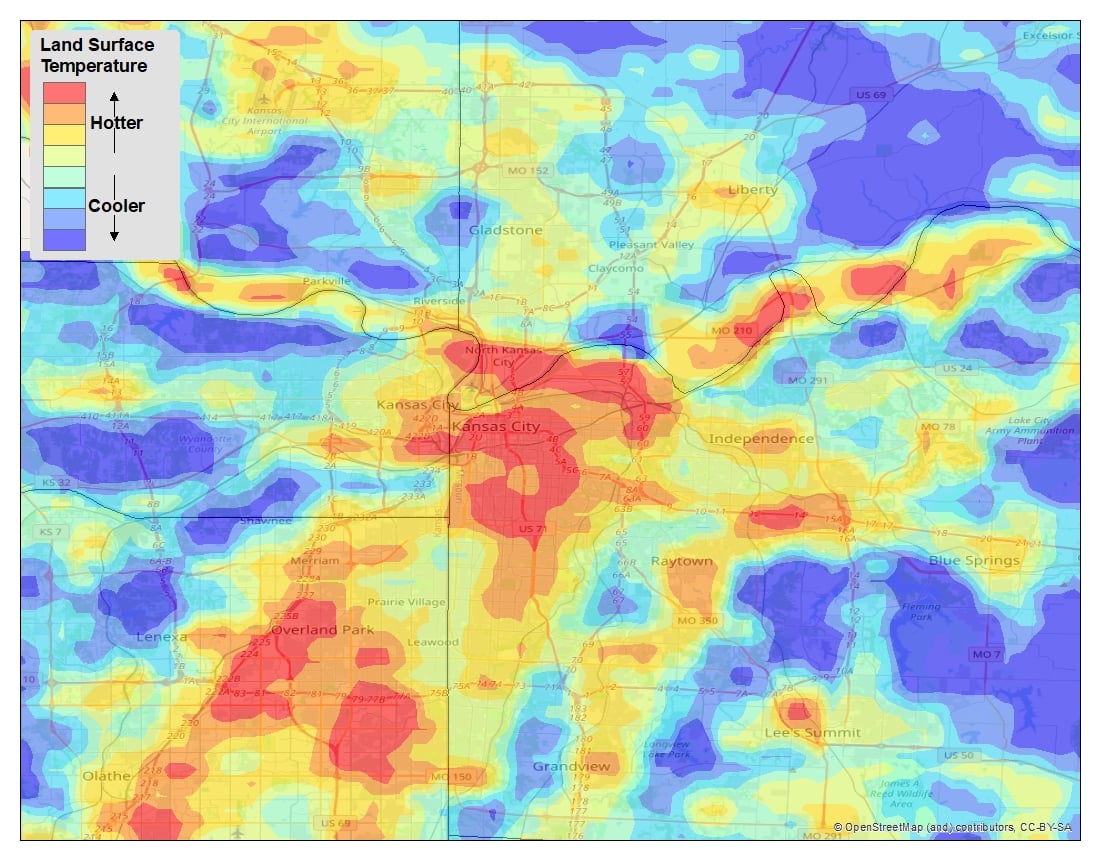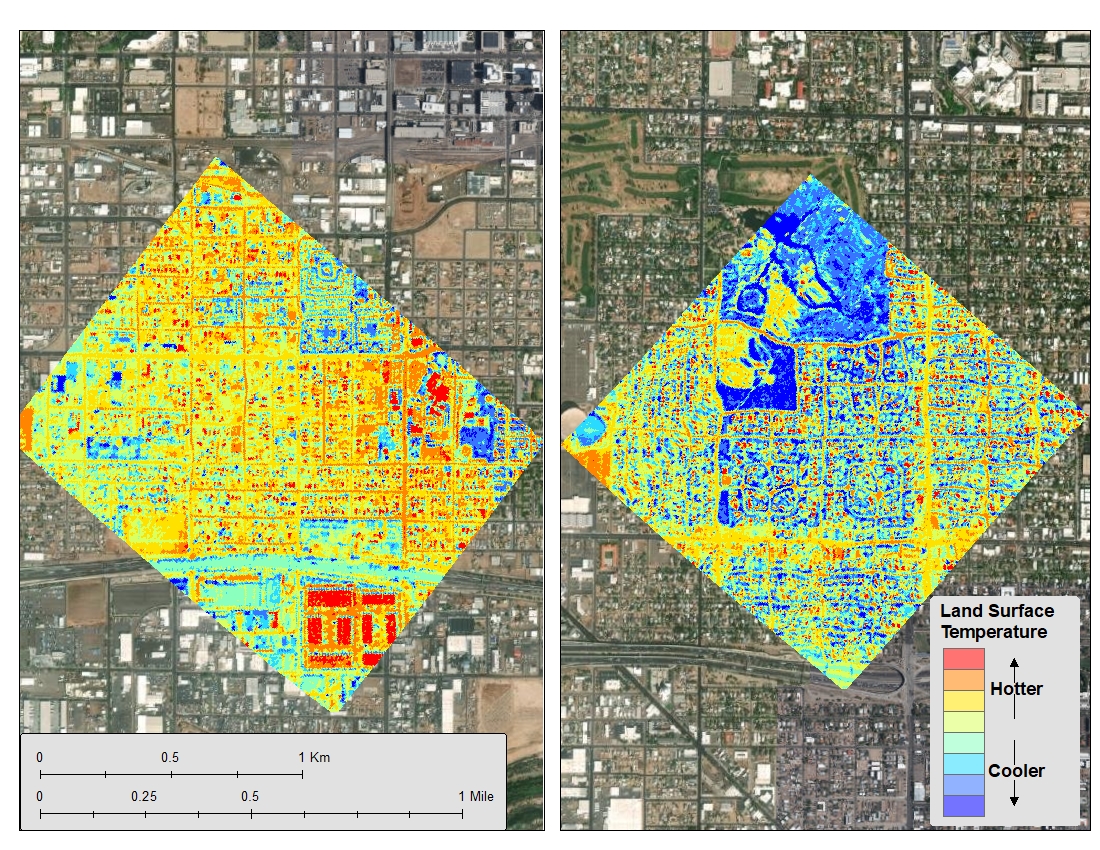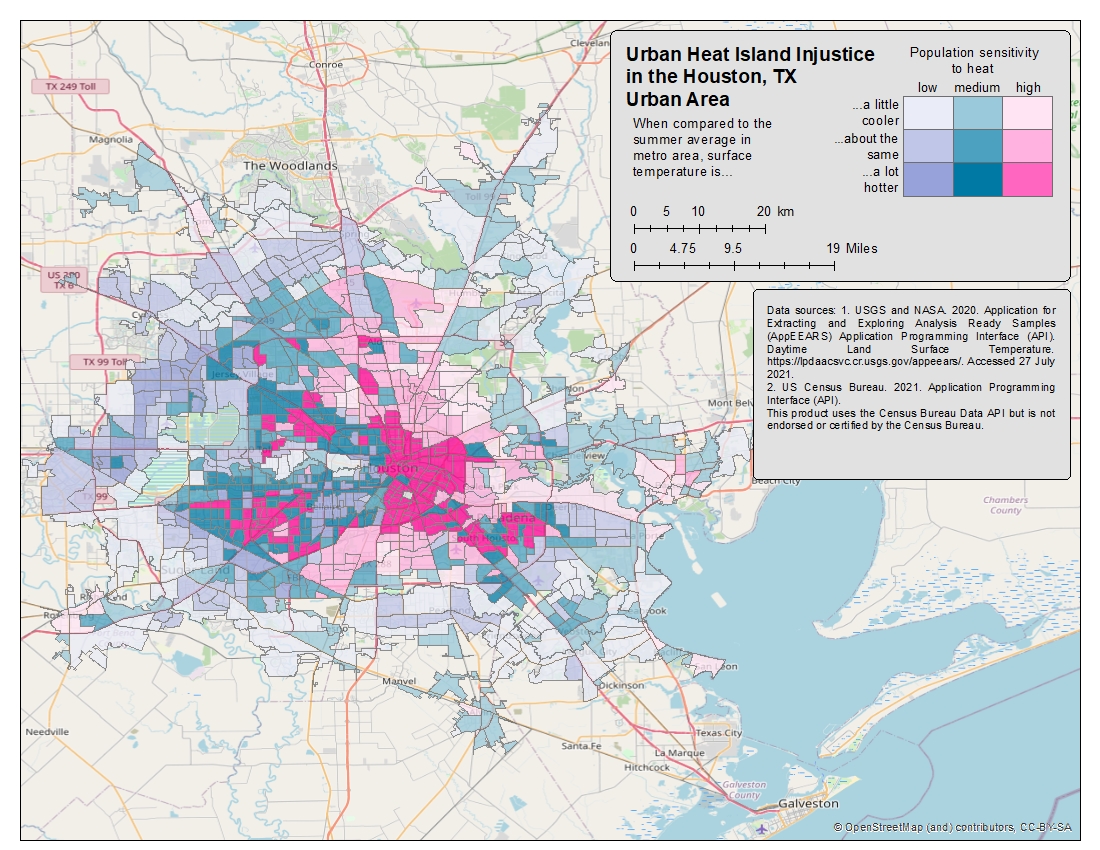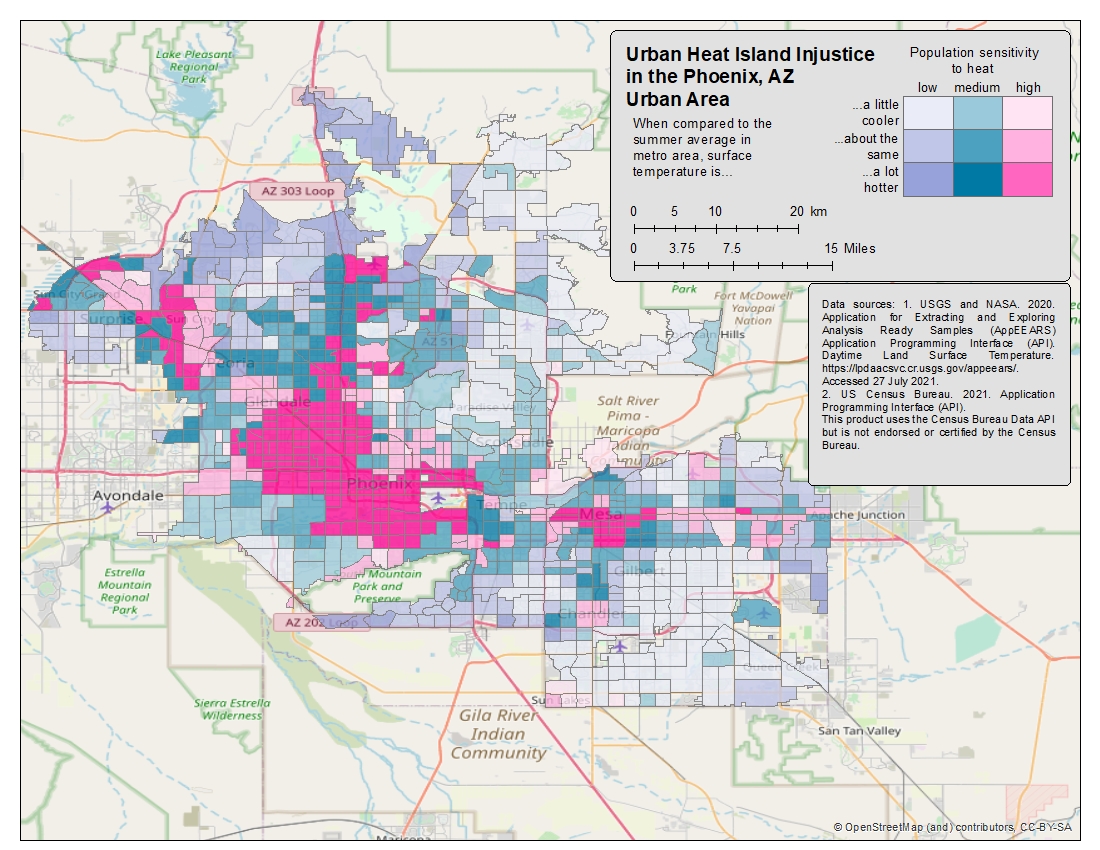Summer heat is most extreme in urban environments. Climatic disruptions are creating deadly and catastrophic heat waves across cities in the Southwest and Southeast, but as we recently saw, also in the Midwest and Pacific Northwest. Heat waves pose greatest risk to children, elderly people, and people with disabilities and certain medical conditions, and to people without the technological and economic means to protect themselves from heat. Disparities also cut across race and ethnicity, as many among these are people of color. As climate change worsens extreme heat, the risk of harm to these populations will increase. Resources are needed to reduce these risks, and climate change mitigation through reduction of heat-trapping emissions is needed to slow the worsening of extreme heat. But mitigation is not yet moving quickly enough. And resources are not yet flowing where they can help the most. This is a climate injustice.
Urban heat islands
Cities have dense concentrations of asphalt, cement, and other surfaces that absorb solar heat during the day and radiate it back into the environment. This makes cities hotter than the more rural, less built-up areas outside them, a phenomenon that scientists call the urban heat island–because when looking at a map of temperatures, cities appear as hot “islands” surrounded by a cooler “ocean” of lower temperatures in the surrounding areas. Locally, urban heat islands increase temperatures already elevated by global climate change.

But large differences in temperatures don’t just occur between cities and rural areas. There are also significant temperature differences within cities due also to the variety of surface covers; these occur at small scales and are called micro-urban heat islands.

Data source credit: Stefanov et al (2015).
And typically, hotter areas in cities are also where most people living with low incomes reside, typically in older housing that is not energy efficient (or that does not circulate air well), with little access to an AC unit (or the means to pay for its use), and near industrial or other hazardous land uses that are not conducive to healthy lives and environments.
An urban climate injustice built on the legacy of fossil fuels and racism
Temperature differences within cities present a clear picture of the environmental injustice of exposure to extreme heat. Study after study after study shows that residents of low-income neighborhoods experience higher temperatures and worse heat-health outcomes. A recent study of 108 urban areas in the US shows that surface temperatures in formerly “redlined” neighborhoods, where mostly people of color have historically lived, are hotter than non-redlined neighborhoods (i.e. with mostly White populations), some by nearly 13°F.
But why are redlined neighborhoods hotter? The basic physical mechanisms are lack of tree cover and an abundance of impervious surfaces that absorb and retain heat, such as pavement and asphalt. But the social and economic mechanisms that created those deficits were racism and urban development policies that excluded people of color. Redlining is a textbook combination of both. Redlining was a racist policy because the only criteria used to assess a mortgage lender’s financial risk of lending to people was the color of their skin. And that had two broad, pernicious effects that persist to this day: first, the systematic denial of intergenerational wealth accumulation to people of color by not allowing them to purchase a home, which is how most households in the US became middle-class and were able to build financially stable lives for their families. In other words, redlining held many generations of people of color captive in poverty. Second, redlined neighborhoods were also deprived of the public investments that make neighborhoods desirable and nice–good schools and good houses, safe and healthy environments, and, of course, trees and open green spaces. Instead, many of those neighborhoods were dumped on, receiving polluting and toxic industries, freeways, and other land uses that are incompatible with healthy lives. And that had an effect on temperatures. Nearly every single one of the redlined neighborhoods in the 108 urban areas in the US in the study I mentioned are hotter than non-redlined areas!
Forecast heat next week highlights the inequities of keeping cool
Extreme heat is in store for parts of the US Southwest as well as Southern Plains states, including Texas and Louisiana this weekend, and may expose the profound climate injustice that people with high sensitivity to heat often live within a city’s hottest neighborhoods. We took a look at what this looks like in Phoenix and Houston, two large metropolitan areas in the Southwest where the heat index between now and early next week is projected to be between 105°F and 110°F.


In metro Phoenix, surface temperatures in the hottest Census tracts run, on average, about 5°F higher in the summer than the average Census tract in the city, but differences among tracts can be up to 14°F. In Houston, the average difference is 7.7°F and can be as large as 20.6°F. While these are surface temperature differences—which are not as well correlated with heat health risks as air temperatures—such differences point to the substantial inequities in exposure to outdoor heat, which often turn deadly when a heat wave hits.
In the maps below, we combined data on how much each tract’s land surface temperature deviates from the metro area average with an indicator that combines factors correlated with increased sensitivity to heat illness or death. These factors are: percent people of color; percent living below the federal poverty threshold; percent without at least a High School diploma; percent 65 years of age or older; percent living with at least one physical or mental disability; percent of households receiving nutritional assistance; and percent living alone. For more information about how we developed this indicator, please click here.
The areas with the fatal combination of temperatures much higher than the average and high population sensitivity to heat are, for the most part, in the downtown core areas of both cities. In these two cities, which both have large immigrant and native-born Hispanic populations, the starkest differences in heat exposure are among Hispanics and people living in poverty in the coolest vs. the hottest neighborhoods. The table below summarizes a few demographics in each city and highlights disparities in exposure to extreme heat.

Climate change could worsen these heat-related injustices. Phoenix has historically experienced 16 days per year with a heat index above 105°F. With no action to reduce global emissions, it would experience 71 such days annually by mid-century. Houston has seen an average of 10 days per year with the heat index over 105°F; by mid-century it could be facing 74 such days without action to reduce heat-trapping emissions.
How to protect people by reducing the inequities of keeping cool in urban heat islands
To reduce the social and environmental inequities of keeping cool, in the short term we need to reduce the sensitivity of at-risk populations while at the same time reducing exposure to heat in cities. We can accomplish those two goals through better heat-health outcomes for at-risk populations and modifications to the built environment of cities. Reducing barriers to access preventative health care can help control pre-existing conditions such as diabetes, obesity, or cardiovascular disease that often trigger illness or death during extreme heat events. Greater access to air conditioners does help reduce the health consequences of heat, and access to energy efficient and weatherized housing is also needed. And we must not forget an often invisiblized heat-health epidemic: people experiencing homelessness face increased risks from heat exposure.
Cooling down our cities can decrease heat exposure, which can be achieved with a combination of increased tree and vegetative cover in ground-level surfaces and roofs, and the use of cooler materials for roofs and pavements (the EPA has a compendium of urban heat island mitigation strategies). These strategies reduce urban heat by shading building surfaces, reflecting more sunlight (instead of absorbing it), and releasing moisture into the air.
Now, cities need to assess the most efficient mix of urban heat mitigation techniques for their particular situation, because the interplay between them and local climate conditions is complex and can have important implications for long-term sustainability. For example, cities in arid environments such as Phoenix, Denver, and Sacramento are trying to address their urban heat islands while also dealing with ongoing regional drought conditions and what that may mean for their water supply.
Clearly, there are no one-size-fits-all solutions. That said, maybe we can take a cue from Phoenix. The city suffers from a dangerous urban heat island effect and sees dozens of heat-related deaths every year, but has an ambitious climate action plan with multiple heat-mitigation goals.
For example, residents of impacted communities, scientists and policymakers are working together to develop “cool corridors” of shaded, walkable areas that protect residents from extreme heat when they walk to and from school, work, the grocery store, and other establishments. The plan also calls on developers to use more reflective materials in new infrastructure to increase what’s called “albedo”—how much radiation a surface reflects—and thus reduce the amount of solar heat that buildings absorb. Finally—and for me this is the sine qua non of equitable urban heat island mitigation—Phoenix plans to achieve a 25 percent tree and shade canopy in pedestrian areas in neighborhoods with the most vulnerable residents.
Every other city across the country would do well to follow the Phoenix example by working together with local residents—especially the most vulnerable—and their advocates to come up with socially equitable solutions to protect those at highest risk of heat-related illness and death, and reduce their urban heat island intensity.
But urban heat adaptation strategies on their own will not allow us to avoid the worst of climate change impacts—for that we need drastic emissions reductions. And the need is urgent. Historically, only three cities in the US have experienced, on average, at least 30 days with a heat index above 105°F. Without action on climate, that number would jump to nearly one-third of the country’s 481 urban areas with a population of at least 50,000 people. That is a lot of heat and a lot of people exposed to it–all of which could be avoided if we get serious about reducing emissions and reducing the local threats that urban heat islands pose to our most vulnerable people.

